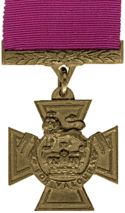Charles Hull (VC)
Charles Hull | |
|---|---|
 | |
| Born | 24 July 1890 Harrogate, West Riding of Yorkshire, England |
| Died | 21 February 1953 Leeds, West Yorkshire |
| Buried | Woodhouse Lane Cemetery, Leeds |
| Allegiance | |
| Service/ | |
| Rank | Corporal |
| Unit | 21st Lancers |
| Battles/wars | World War I |
| Awards | Victoria Cross Croix de Guerre |
| Other work | Police officer |
Charles Hull VC (24 July 1890 – 21 February 1953) was an English recipient of the Victoria Cross, the highest and most prestigious award for gallantry in the face of the enemy that can be awarded to British and Commonwealth forces during the First World War.
Details
Hull was 25 years old, and a private in the 21st Lancers (Empress of India's), British Army during the First World War when the following deed took place on the North West Frontier of British India for which he was awarded the VC.
On 5 September 1915 at Hafiz Kor, N.W. Frontier, India, Private Hull rescued an officer from certain death at the hands of the tribesmen. The citation was published in the London Gazette on 3 March 1916 and read:
"1053 Private (Shoeing-Smith) Charles Hull, 21st Lancers. For most conspicuous bravery. When under close fire of the enemy, who were within a few yards, he rescued Captain G. E. D. Learoyd, whose horse had been shot, by taking him up behind him and galloping into safety. Shoeing-Smith Hull acted entirely on his own initiative, and saved his officer's life at the imminent risk of his own."[1]
He later achieved the rank of corporal. After the war he joined Leeds Constabulary.
The Medal
His VC is on display in The Queen's Royal Lancers and Nottinghamshire Yeomanry Museum in Thoresby Park, Nottinghamshire.
References
- ^ "No. 29496". The London Gazette. 3 March 1916.
External links
- Harrogate People
- British Legion
- Location of grave and VC medal (West Yorkshire)
